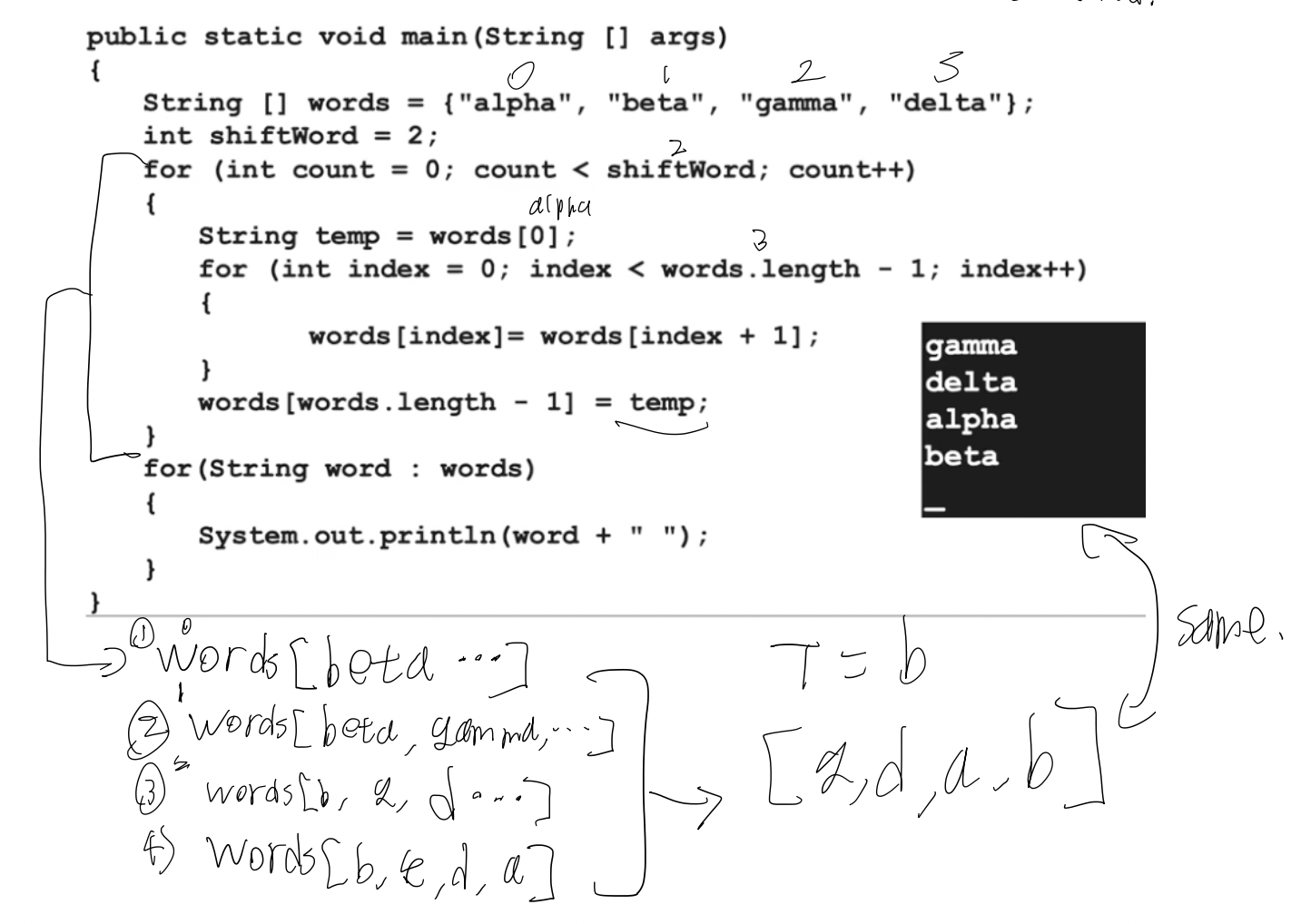6. Arrays
/*
Writer: SP
Date: April 1st
References: knowt & Fiveable
Unit 6: Arrays */Arrays Intro
Arrays- A data structure that makes it easier to handle similar types of data.
It can store whether primitive or reference data types.
Arrays are also reference types
Making Arrays
There are two different ways to make arrays
A constructor method vs. A pre-initialized array.
Constructor Method:
dataType[] arrayName = new dataType[numberOfItems];To make an array that hold 10 items, it will be: int[] Array = new int[10];
Default value of array
Datatype
Default Value
int
0
double
0
boolean
false
reference
null
Pre-initialized Arrays:
int[] arrayOne = {1,2,3,4,5,6};We initialized an array of 6 integers.
Accessing elements
code to access elements: arrayName[index]
Java is a zero-indexed language, thus its index starts at 0.
To define the length of array, we use arrayName.length.
It is not index thingy, so it will return the correct number.
Want to access the last element using .length, you should write: ;
arrayName.length - 1
ArrayIndexOutOfBoundsException:
When we use an index outside the allowed range.
Traversing Arrays:
To access every value in the array.
Basic Traversing
// Traversing all elements using for loop and start at index 0.
int[] list = new int[5];
for (int i = 0; i < list.length; i++) {
condition;
}// Traversing all elements using while loop and start at index 0.
int[] list = new int[5];
int i = 0;
while (i<list.length) {
condition;
i++;
}Reverse Traversing
int[] arr = new int[5];
for (int i = arr.length-1; i<=0; i—-) {
condition;
}
int index = arr.length-1;
while (index<=0) {
condition;
i—-;
}Enhanced For Loop
Enhanced for loop can be used to traverse through most data structures.
It cannot reverse.
Structure:
for (dataType i : arrayName) {
do something with i;
}We cannot directly change the value of elements using enhanced for loop because ‘i’ is just copy of element in the array.
However, we can use mutator methods to set the value.
/** Represents a student
*/
public class Student {
private String name;
/** Sets the name of the Student
*/
public void setName(String name) {
this.name = name;
}
/** Other instance variables, methods, and constructors not shown
*/
}
// IN ANOTHER CLASS
/** Resets all students' names
*/
public static void doubleArray(Student[] array, String defaultName) {
for (Student student: array) {
student.setName(defaultName); // Sets each student's name to a default name
}
}Developing Algorithms
Reverse the array
public class ReverseArray {
public static void main(String[] args) {
// Initializing an array
int[] originalArray = {1, 2, 3, 4, 5};
int length = originalArray.length;
// Printing the original array
System.out.println("Original Array:");
for (int i = 0; i < length; i++) {
System.out.print(originalArray[i] + " ");
}
// Reversing the array
for (int i = 0; i < length / 2; i++) {
int temp = originalArray[i];
originalArray[i] = originalArray[length - 1 - i];
originalArray[length - 1 - i] = temp;
}
// Printing the reversed array
System.out.println("\nReversed Array:");
for (int i = 0; i < length; i++) {
System.out.print(originalArray[i] + " ");
}
}
}Finding Max in array of double values (Comparing with the first index value):
private double findMax(double[] v) {
double max = v[0];
for (int i = 1; index < v.length; i++) {
if (v[i] > max) {
max = v[i];
}
}
return max
}Finding Min value in int array (Comparing with the absolute maximum value):
private int findMin(int[] v) {
int min = Integer.MAX_VALUE;
for (int currentValue : v) {
if (currentValue < min) {
min = currentValue;
}
}
return min;
}Calculate the average value of array
private double findMean(double[] list) {
double sum = 0.0;
for (int i : list) {
sum += i;
}
double mean = sum/list.length;
return mean;
}Doing a right shift.
 5. Left Shift
5. Left Shift
 6. Finding Duplicate
6. Finding Duplicate
for (int x = 0; x < Array.length; x++) {
for (int y = 0; y< Array.length; y++) {
if (array[x] == array[x] && x!=y) {
// Duplicate statement
}
}
}